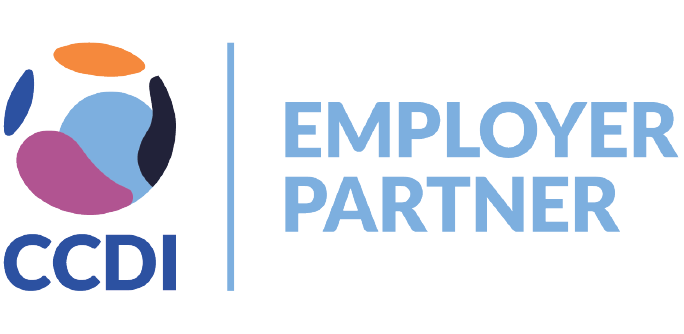The WSIB is where potential meets purpose. To reach our potential and live up to our purpose, we’re building an inclusive work environment that reflects the people we serve.
Our vision for equity, diversity and inclusion
We are an equitable, diverse, and inclusive place to work for everyone.
We foster a safe, inclusive and respectful environment for employees, customers and stakeholders.
Our dynamic workforce reflects the people we serve.
Our EDI priorities
We reflect who we serve
We’re inclusive by design in every way we work
We all contribute to our inclusive environment
Everyone has the opportunity to reach their full potential
We share accountability for making progress
We’re working together to make the WSIB a place where everyone can thrive. Everyone is accountable for taking action every day to achieve our priorities and has a performance objective to contribute to an inclusive workplace culture. There are many ways to contribute, including through groups such as our EDI Advisory Council, Listening groups and Employee Resource Groups.
The EDI Advisory Council is an employee-led group that amplifies the voice of our team to support and implement our EDI priorities.
Listening groups are affinity-based communities and forums for discussion, networking and peer support. We have listening groups for Bilingual, Indigenous, Muslim, Jewish, and Christian employees and are adding to this list.
Employee Resource Groups (ERGs) help to create an inclusive workplace through networking, storytelling, ally engagement, career development and community engagement.
- Women’s Professional Network (WPN) supporting women’s career development
- Pride Forward supporting 2SLGBTQIA+ career development and engaging allies
- Black Employee Excellence Network (BEEN) supporting Black employees’ career development
- Advocating for Learning, Inclusion, Growth, Neurodiversity & Disability (ALIGN'D) supporting a culture of inclusion for disability and neurodiversity
- Pan-Asian Group of Employees (PAGE) supporting the career development of Asian employees
These groups are critical in advancing our EDI priorities. We engage and listen to these groups as key partners.
I helped to coordinate WSIB’s participation in three Pride Parades since 2023 in partnership with the EDI Advisory Council. I am beyond excited to build on these successes as we grow this new ERG, Pride Forward.
Sarah, Pride Forward co-chair
Pride Forward’s goal is to support a welcoming and inclusive culture at the WSIB for all LGBT2SQIA+ colleagues. I am proud to be contributing to this important work.
Aaron, Pride Forward co-chair
The foundation of BEEN reflects the hopes and aspirations I have held since starting with the WSIB 20 years ago. I feel privileged to help create a space, with a focus on empowerment and excellence, for the many of us who identify as part of the Black and African diaspora and look forward to where this journey takes us.
Joanne, BEEN co-chair
Being a part of BEEN, means being able to help fellow Black employees and prospective Black employees achieve their best. This is a passion project, showcasing our imagination, drive, analytical prowess, and empathy. I am excited for what the future holds for BEEN.
David, BEEN co-chair
My time as an EDI Advisory Council co-chair has been an eye-opening and heartwarming journey. Diversity is a reality we can’t ignore, but inclusion? That’s the choice we make. And it’s a choice that leads us toward the ultimate goal: belonging. Feeling like you truly belong at work isn’t just nice-to-have—it’s the cornerstone of everything we’re trying to achieve.
Rachel, EDI Advisory Council co-chair
Actions we are taking to advance toward our priorities
Investing in career development: We are developing the next generation of leaders through our mentorship program for aspiring leaders from equity-deserving backgrounds. This six-month program connects mentees from historically underrepresented groups with mentors in the organization who are passionate about sharing their business insights and strengths to help others achieve professional development goals.
Continuous learning opportunities: We create opportunities for learning as part of our enterprise-wide Inclusion Matters speaker series featuring thought leaders and acclaimed speakers.
Developing inclusive leaders: We integrate practical inclusive leadership content in our leadership training programs to support leaders in creating diverse and dynamic teams.
Data-driven approach: We are accelerating towards a data-driven approach by collecting demographic data as part of our Diversity Dimensions initiative. This data will drive action and accountability towards our priorities and goals. You can view our current demographic representation here.
Inclusion makes us better, easier and faster to work with
Inclusive and accessible customer experiences are integrated in our Strategic Plan. Read more in our Impact Report about how we are partnering with different organizations and communities to make it better, easier, and faster for all our customers.
Land acknowledgement
In the spirit of truth and reconciliation, we acknowledge that the land we inhabit today and on which we operate our offices across Ontario are traditional territories of Indigenous Peoples. We recognize the history, spirituality, culture and stewardship of the land of Indigenous Peoples. We are grateful to all Indigenous groups for their commitment to protect the land and its resources. We are committed to advancing reconciliation, partnership and enhanced understanding.




















